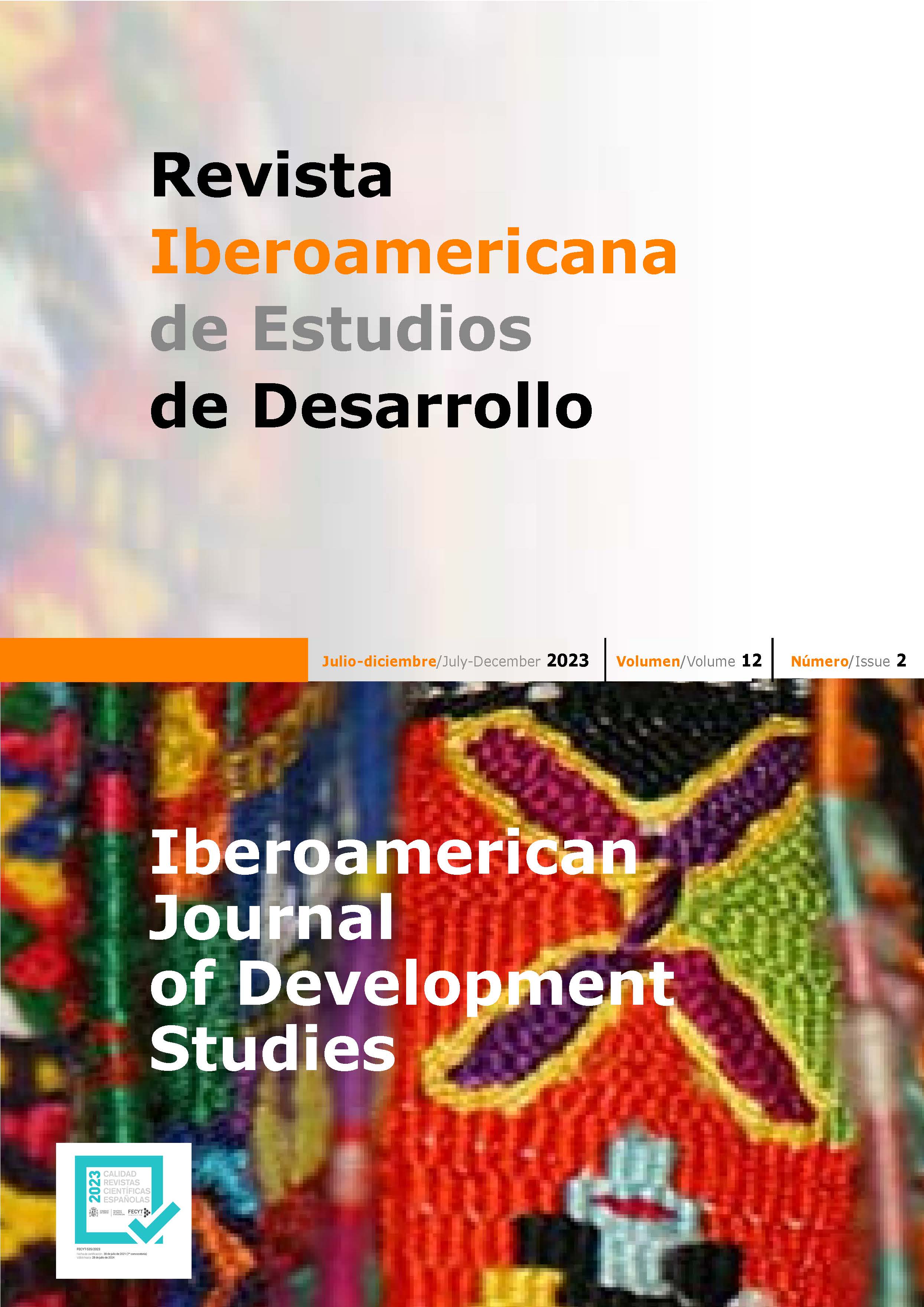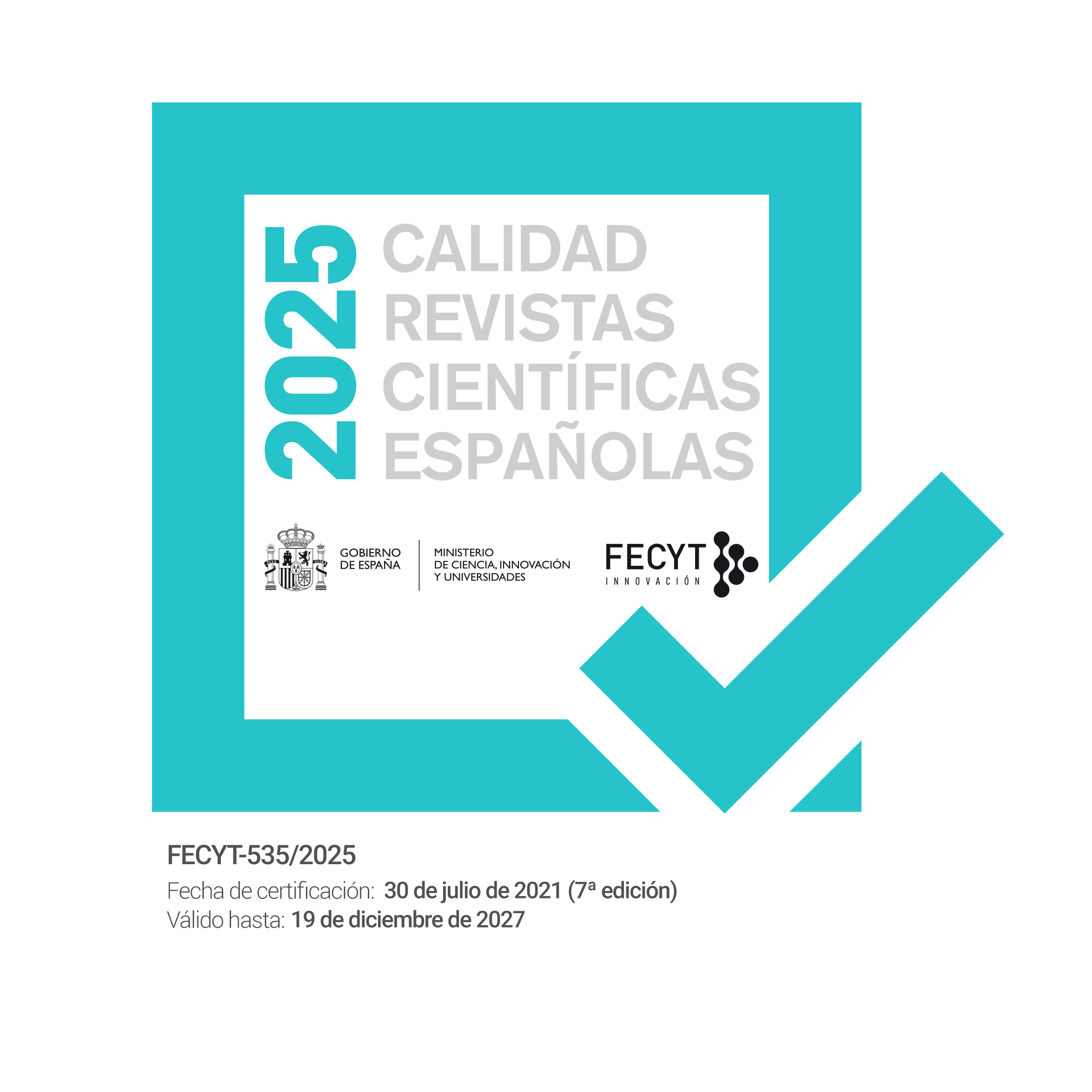Las cadenas globales de producción en el marco de la disputa hegemónica mundial. Consideraciones para el desarrollo de América Latina
DOI:
https://doi.org/10.26754/ojs_ried/ijds.830Palabras clave:
cadenas globales de producción, hegemonía, desarrollo, América LatinaResumen
En el presente trabajo se analiza la configuración y expansión de las cadenas globales de producción (CGP), así como su posterior ralentización, desde una mirada sistémica de largo plazo. Específicamente, se sitúan estos procesos en la fase de agotamiento del ciclo sistémico de acumulación hegemonizado por Estados Unidos y de emergencia de un nuevo espacio que dinamiza la producción capitalista a nivel global y que se presenta como potencial relevo hegemónico: el este de Asia, comandado, en la actualidad, por China. Sobre este escenario de disputa, se examinan las posibilidades y limitaciones que la participación en las CGP presenta para el desarrollo latinoamericano. Se advierte que, hasta el momento, la inserción en la producción globalizada no ha favorecido el desarrollo de los países de la región. Sin embargo, se reconoce la posibilidad de modificar esta situación a partir de avanzar en la configuración de cadenas regionales de producción que cualifiquen su participación en las CGP.
Descargas
Referencias
AKAMATSU K (1962). A Historial Pattern of Economic Growth in Developing Countries. The Developing Economies 1(1):3-25.
AMAR A, TORCHINSKY LANDAU M (2019). Cadenas regionales de valor en América del Sur. Cepal-Naciones Unidas, Santiago de Chile.
AMSDEN A (2001). The Rise of the Rest: Challenges to the West from the Late-Industrializing Economies. Oxford University Press, Nueva York.
ANTRÀS P (2020). De-globalisation? Global Value Chains In The Post-Covid-19 Age. NBER Working Paper 28115.
ARRIGHI G (1999). El largo siglo XX. Akal, Madrid.
ARRIGHI G (2007). Adam Smith en Pekín. Orígenes y fundamentos del siglo XXI. Akal, Madrid.
BALDWIN R (2012). Global supply chains: why they emerged, why they matter, and where they are going. CEPR Discussion Papers 9103.
BANCO MUNDIAL (2022). Datos de libre acceso del Banco Mundial. https://datos.bancomundial.org/, acceso 17 de octubre de 2022.
BLYDE J (2013). The Participation of Mexico in Global Supply Chains. The Challenge of Adding Mexican Value. Inter-American Development Bank Technical Note 596.
BLYDE J (2014). Synchronized Factories Latin America and the Caribbean in the Era of Global Value Chains. Springer, Washington DC.
BOYER R, DURAND JP (1997). After Fordism. Macmillan Press, Londres.
CADESTIN C, GOURDON J, KOWALSKI P (2016). Participation in Global Value Chains in Latin America: implications for trade and trade-related policy. OECD Trade Policy Papers 192.
CALLEGARI J, MASSAROLI MELO T, CARVALHO C (2018). The peculiar insertion of Brazil into global value chains. Review of Development Economics 22(3):1321-1342.
CASTELLS M (1992). Four Asian Tigers With a Dragon Head. A Comparative Analysis of the State, Economy, and Society in the Asian Pacific Rim. En: Appelbaum R, Henderson JW (eds.). States and Development in the Asian Pacific Rim. Sage, Londres, pp. 33-70.
CIGNA S, GUNNELLA V, QUAGLIETTI L (2022). Global value chains: measurement, trends and drivers. European Central Bank Occasional Paper Series 289.
DEGAIN C, MENG B, WANG Z (2017). Recent trends in global trade and global value chains. En: Measuring and analyzing the impact of GVCs on economic development. World Bank, Washington DC, pp. 37-60.
DICKEN P (2015). Global Shift. Mapping the Changing Contours of the World Economy. The Guilford Press, Nueva York.
DUAN Y, DIETZENBACHER E, JIANG X, CHEN X, YANG C (2018). Why has China’s vertical specialization declined? Economic Systems Research 30(2):178-200.
DUNNING JH, LUNDAN S (2008). Multinational Enterprises and the Global Economy. Edward Elgar, Reino Unido.
DURÁN LIMA J, ZACLICEVER D (2013). América Latina y el Caribe en las cadenas internacionales de valor. Cepal, Santiago de Chile.
EPSTEIN G (2005). Introduction: Financialization and the World Economy. En: Epstein G (ed). Financialization and the World Economy. Edward Elgar Publishing, Reino Unido, pp. 3-16.
EVANS P (1995). Embedded Autonomy: States and Industrial Transformation. Princeton University Press, Princeton.
FERNÁNDEZ VR (2017). La trilogía del erizo-zorro. Redes globales, trayectorias nacionales y dinámicas regionales desde la periferia. Anthropos Editorial/Universidad Nacional del Litoral, Barcelona.
FERNÁNDEZ VR, LAUXMANN C, TREVIGNANI M (2014). Emergencia del Sur Global. Perspectivas para el desarrollo de la periferia latinoamericana. Economia e Sociedade 23(3):611-643.
FONDO MONETARIO INTERNACIONAL (2022). World Economic Outlook Database. October 2022. https://www.imf.org/en/Publications/WEO/weo-database/2022/October , acceso 17 de octubre de 2022.
FRÖBEL F, HEINRICHS J, KREYE O (1980). La nueva división internacional del trabajo. Siglo XXI, Madrid.
GABUSI G (2017). The reports of my death have been greatly exaggerated: China and the developmental state 25 years after Governing the Market. The Pacific Review 30(2):232-250.
GARCÍA-HERRERO A, TAN J (2020). Deglobalisation in the context of United States-China decoupling. Bruegel, Policy Contribution 21.
GEREFFI G (1996).Global commodity chains: new forms of coordination and control among nations and firms in international industries. Competition and Change 1(4):427-439.
GEREFFI G (1999). International trade and industrial upgrading in the apparel commodity chain, Journal of International Economics 48(1):37-70.
GEREFFI G, KORZENIEWICZ M (1994). Commodity Chains and Global Capitalism, Commodity Chains and Global Capitalism. Praeger, Westport.
GLASSMAN J (2011). The Geo-political Economy of Global Production Networks. Geography Compass 5(4):154-164.
GLYN A, HUGES A, LIPIETZ A, SINGH A (1988). The Rice and Fall of the Golden Age.WIDER Working Papers 43.
GORDON D, WEISSKOPF T, BOWLES S (1996). Power, Accumulation, and Crisis: The Rise and Demise of Postwar Social Structure of Accumulation. En: Lippit VD (ed.). Radical Political Economy: Explorations in Alternative Economic Analysis. Routledge, Nueva York.
HARVEY D (2007). Breve historia del neoliberalismo. Madrid, Akal.
HAUGE J (2020). Industrial policy in the era of global value chains: towards a developmentalist framework drawing on the industrialisation experiences of South Korea and Taiwan. The World Economy 43(8):2070-2092.
HORNER R, NADVY K (2018). Global value chains and the rise of the Global South: unpacking twenty-first century polycentric trade. Global Networks 18(2):207-237.
INTERNATIONAL MONETARY FOUND (2022). World Economic Outlook Database. https://www.imf.org/en/Data, acceso 17 de octubre de 2022.
JESSOP B (1992). Fordism and Post-Fordism: a Critical Reformulation. En: Scott AJ, Storper MJ (eds.). Pathways to Regionalism and Industrial Development. Routledge, Londres.
KASAHARA S (2013). The Asian developmental State and the flying geese paradigm. United Nations Discussion Papers n.º 213.
KINKEL S (2012). Trends in production relocation and backshoring activities. Changing patterns in the course of the global economic crisis. International Journal of Operations & Production Management 32(6):696-720.
KINKEL S, DEWANTI RT, ZIMMERMANN P, COATES R (2017). Measuring reshoring trends in the EU and the US. MAKERS Deliverable 4.1.
KRIPPNER G (2005). The financialization of the American economy. Socio-Economic Review 3(2):173-208.
KWAN C (2002). The rise of China and Asia’s flying-geese pattern of economic development: an empirical analysis based on US import statistics. Research Institute of Economy, Trade and Industry (RIETI), Discussion Paper Series 02-E-009.
LI X, MENG B, WANG Z (2019). Recent patterns of global production and GVC participation. En: Global Value Chain Development Report 2019: Technological Innovation, Supply Chain Trade, and Workers in a Globalized World. World Trade Organization, Washington DC, pp. 9-43.
MEDIALDEA GARCÍA B, SANABRIA M (2013). La financiarización de la economía mundial: hacia una caracterización. Revista de Economía Mundial 33:195-227.
MERINO G, BILMES J, BARRENENGOA A (2021). Crisis de hegemonía y ascenso de China. Seis tendencias para una transición. Instituto Tricontinental de Investigación Social, Buenos Aires.
MILBERG W, WINKLER D (2013). Outsoursing Economies. Global Value Chain in Capitalist Development. Cambridge University Press, Cambridge.
MOLINA O, OLIVARI J, PIETROBELLI C (2016). Global Value Chains in the Peruvian Mining Sector.Inter-American Development Bank Technical Note 1114.
OECD (2015). Diagnostic of Chile’s Engagement in Global Value Chain. OECD.
ORGANIZACION MUNDIAL DEL COMERCIO (2022). WTO Stats. https://stats.wto.org/, acceso 17 de octubre de 2022.
PECK J (2001). Neoliberalizing states: thin policies/hard outcomes. Progress in Human Geography 25(3):445-455.
PECK J, TICKELL A (2002). Neoliberalizing Space. Antipode 34(3):380-404.
PIORE M, SABEL C (1990). La segunda ruptura industrial. Alianza, Madrid.
ROSALES O (2022). El conflicto Estados Unidos-China y las perspectivas del «desacoplamiento estratégico». El Trimestre Económico 89(354):491-531.
SCHOLVIN S, TUROK I, VISAGIE J, REVILLA DIEZ J (2022). Regional value chains as new pathways to development? Area Development and Policy 7(2):177-186.
SCHTEINGART D, SANTARCÁNGELO J, PORTA F (2017). La inserción Argentina en las Cadenas Globales de Valor. Asian Journal of Latin American Studies 30(3):45-82.
STURGEON T (2002). Modular production networks: a new American model of industrial organization. Industrial and Corporate Change 1(3):451-496.
TATE W (2014). Offshoring andreshoring: U.S. insights and research challenges. Journal of Purchasing & Supply Management 20:66-68.
TREACY M (2021). Great chaos under heaven: strategies and challenges for consolidating China’s global hegemony in the 21st century. En: Shei C, Wei W (eds.). The Routledge Handbook of Chinese Studies. Routledge.
TREVIGNANI M, LAUXMANN C, VALENTINUZ M (2022). Introduciendo al Estado para el desarrollo en el enfoque de cadenas globales de valor. Problemas del Desarrollo 53(209):3-26.
URIBE ESCOBAR JD (2016). Colombia y las cadenas globales de valor. Revista del Banco de la República 1063:5-14.
WADE R (1990). Governing the Market: Economic Theory and the Role of the Government in East Asian Industrialization. Princeton University Press, Princeton.
WORLD BANK (2017). Measuring and Analyzing the Impact of GVCs on Economic Development. World Bank, Washington DC.
WORLD BANK (2020). World Development Report.Trading for Development in the Age of Global Value Chains. World Bank, Washington DC.
WORLD TRADE ORGANIZATION (2019). Global Value Chain Development Report 2019: Technological Innovation, Supply Chain Trade, and Workers in a Globalized World. World Trade Organization, Washington DC.
XING L, BERNAL-MEZA R (2021). China-US rivalry: a new Cold War or capitalism’s intra-core competition? Revista Brasileira de Política Internacional 64(1).
YUE P, EVENETT S (2010). Moving up the value chain: upgrading China’s manufacturing sector. International Institute for Sustainable Development (IISD) Report.
ZACLICEVER D (2017). Trade integration and production sharing A characterization of Latin American and Caribbean countries’ participation in regional and global value chains. Cepal, Santiago de Chile.
Descargas
Publicado
Número
Sección
Licencia
Derechos de autor 2023 Carolina Teresita Lauxmann, Víctor Ramiro Fernández

Esta obra está bajo una licencia internacional Creative Commons Atribución-NoComercial-SinDerivadas 4.0.






